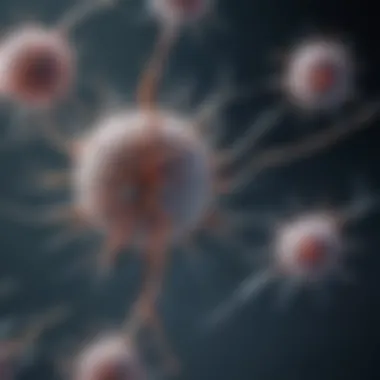Dendritic Cell Therapy: A New Frontier in Cancer Treatment


Intro
Dendritic cells serve as vital sentinels in the immune system, playing a key role in bridging innate and adaptive immunity. Their unique ability to process and present antigens makes them extraordinary players in how our bodies recognize and combat cancer cells. This narrative seeks to explore the burgeoning interest in dendritic cell therapy as a promising avenue for cancer treatment.
Understanding why cancers arise and how they evade the body’s defenses is crucial. As researchers delve deeper into these facets, dendritic cell therapy emerges as a sophisticated strategy aimed at equipping the immune system with the necessary tools to tackle malignancies more effectively. Equipped with insights from current studies and a clearer outline of methodologies, one can truly appreciate the transformative potential this therapy holds.
Research Overview
Key Findings
The exploration into dendritic cell therapy has illuminated several significant findings:
- Enhanced Immune Response: Clinical trials show that therapies specifically targeting dendritic cells lead to a more robust immune response against tumors.
- Customizability: Dendritic cells can be isolated and manipulated to present specific tumor antigens, tailoring treatments that are unique to individual patients.
- Survival Rates: Preliminary data indicates improved survival rates in patients treated with dendritic cell therapy compared to standard methods.
Study Methodology
To better understand this therapy, researchers have used a variety of methodologies:
- Cell Isolation: Dendritic cells are harvested from patients, often sourced from blood or tissue samples.
- Antigen Loading: The isolated cells are exposed to tumor antigens, allowing them to educate the immune system about the specific threats posed by cancer.
- Re-infusion: After this process, these activated dendritic cells are reintroduced to the patient’s body, where they kickstart a targeted immune response.
Background and Context
Historical Background
The journey of dendritic cells in cancer therapy began in the late 20th century. Researchers recognized their potential when studies demonstrated that these cells could initiate strong immune responses. The early 2000s marked the transition from experimental research to clinical trials, paving the way for legitimate options in cancer immunotherapy.
Current Trends in the Field
Recent trends point toward a deeper understanding of dendritic cell biology and a push for more personalized approaches:
- Combination Therapies: Ongoing research examines how combining dendritic cell therapy with other treatments, like checkpoint inhibitors, can yield better outcomes.
- Vaccine Development: There’s an increasing focus on developing dendritic cell vaccines that can be employed alongside conventional therapies.
- Broadening Applications: Exploring the use of dendritic cells beyond cancer, such as in autoimmune diseases, indicates a bright future for this field.
Dendritic cell therapy is not just a hopeful notion; it symbolizes a shift towards empowering the body’s own defenses against the complexities of cancer.
In summary, dendritic cell therapy represents a pivotal development in cancer treatment. It's an area where science and innovation meet, urging us to look forward to the evolving landscape of immunotherapy in delivering better patient outcomes.
Prologue to Dendritic Cell Therapy
Dendritic cell therapy represents a promising frontier in cancer treatment, tapping into the unique ability of the immune system. The fundamental idea here is to potentiate the body’s own defenders—dendritic cells—enabling them to recognize and combat cancerous cells more effectively. This creates a new paradigm in the fight against malignancies, making a significant leap from conventional therapies.
These specialized immune cells function as sentinels, capturing and presenting antigens from pathogens or abnormal cells to T cells. It’s through this process that immune responses are ignited, marking the initiation of a battle against cancer. The importance of exploring dendritic cell therapy lies not only in its innovative approach but also in its potential to improve outcomes for patients who have limited options available through traditional methods.
Definition and Concept
Dendritic cell therapy refers to a method wherein dendritic cells are harvested, often from the patient’s own body, and then exposed to tumor-associated antigens in a laboratory setting. The intent is to train these cells so that upon reinfusion into the patient, they can elicit a robust immune response against the tumor. This sophisticated form of immunotherapy aims at creating a targeted attack, aiming to reduce side effects often associated with conventional chemotherapies.
It’s like turning the immune system into a finely-tuned search party, capable of seeking out cancer cells with precision. When successful, this immune response can lead to tumor regression and improved survival rates. The concept challenges the traditional views of cancer treatment by focusing on customizing therapies based on individual patient profiles, a vital aspect of modern medicine.
Historical Context
The roots of dendritic cell therapy can be traced back to the 1970s, when dendritic cells were first identified and linked to the immune response. Early studies suggested a pivotal role for these cells in immune tolerance and activation. However, the path from laboratory discoveries to clinical applications has been a protracted journey.
In the 1990s, substantial progress was made when researchers successfully demonstrated that dendritic cells could be manipulated to enhance immune responses against tumors. Trials began in earnest, and gradually, the potential of dendritic cells became evident. For instance, in 2010, the U.S. Food and Drug Administration approved sipuleucel-T, a dendritic cell-based therapy for prostate cancer, marking a watershed moment in the annals of cancer treatment. This event paved the way for subsequent therapies and trials targeting various cancer types, which we will delve into later in this article.
Understanding Dendritic Cells
The role of dendritic cells in the immune system warrants a thorough understanding, particularly in the context of cancer treatment. They act as pivotal sentinels and messengers, bridging innate and adaptive immunity. Their ability to process and present antigens plays a crucial role in activating T cells, which are the warriors against malignancies. By getting a grasp on how dendritic cells work and interact with other immune cells, one can appreciate their potential in therapeutic strategies.
This section delves into their function, highlighting the significance of dendritic cells not only in conventional immunology but also in the more specialized field of cancer immunotherapy.
Role in the Immune System
Dendritic cells are often portrayed as the "gatekeepers" of the immune system. They are adept at recognizing pathogens and abnormal cells, including tumors. When they encounter these threats, dendritic cells engulf them, a process known as phagocytosis. Following this, they meticulously dissect the invader, breaking it down into smaller pieces, or antigens.
Once they have this information, dendritic cells migrate to lymph nodes, where they present these antigens to T cells. This crucial step is akin to a chef presenting a dish to diners, evoking the right response. The interactions between dendritic cells and T cells are key to initiating a well-coordinated immune response. In cancer treatment, enhancing this dynamic can amplify the body's ability to fight tumors.
Types of Dendritic Cells
Dendritic cells aren't a monolithic entity; they can be divided into various types based on their origin and function. Two prominent subtypes are Conventional Dendritic Cells and Plasmacytoid Dendritic Cells, each playing distinct roles in immune responses.
Conventional Dendritic Cells
Conventional dendritic cells (cDCs) are often the go-to choice in immunotherapy due to their efficiency in antigen presentation. They are characterized by their capability to pick up a broad range of antigens and migrate to lymph nodes, activating T cells effectively. Their main advantage lies in their strong ability to stimulate CD4+ and CD8+ T cells.


In the realm of cancer, these cells offer a few unique features: they can be equipped with additional co-stimulatory molecules that enhance T cell activation and they respond well to different tumor microenvironments. However, there are challenges too; the variability in their ability to present antigens depending on the tumor type complicates matters, making standardization a puzzle to solve.
Plasmacytoid Dendritic Cells
Plasmacytoid dendritic cells (pDCs), on the other hand, are often referred to as the "natural interferon-producing cells". They are notable for their rapid production of type I interferons, especially in response to viral infections and some tumor types. This characteristic makes pDCs vital in the immune response, primarily during the early stages of invasion.
However, when it comes to their role in cancer therapy, their effectiveness can be a double-edged sword. While they induce strong antiviral responses, their presence in tumors can sometimes lead to an immunosuppressive environment, which hampers the effectiveness of systemic therapies. Thus, understanding pDCs contributes to a balanced perspective on dendritic cell therapy; they are beneficial but must be carefully managed in therapeutic contexts.
Mechanisms of Action
Understanding the mechanisms of action in dendritic cell therapy is crucial. This is where the rubber meets the road in terms of how these therapies potentially change the battlefield of cancer treatment. It isn’t just about introducing dendritic cells into the body; it's about knowing how these cells interact with other immune components to fight cancer more effectively. When we dissect this segment, we find two fundamental pillars: antigen presentation and T cell activation, both of which play key roles.
Antigen Presentation
At the heart of dendritic cell therapy is antigen presentation. Dendritic cells act as the sentinels of the immune system. They are constantly on the lookout for any foreign invaders—be it a virus, bacteria, or cancerous cells. Once they catch sight of their target, they engulf it and break it down into smaller pieces, known as antigens. This process is akin to a chef preparing fine hors d'oeuvres for a banquet. The dendritic cells process these antigens and present them on their surface, equipped with special molecules called major histocompatibility complex (MHC) proteins.
This presentation is vital because it essentially serves as a menu for T cells, who are the soldiers of the immune system. T cells can only launch an attack when they've seen this specific menu, making antigen presentation a game changer. Essentially, if dendritic cells don’t present antigens properly, T cells may remain dormant and thus ineffective against the cancerous cells.
"Dendritic cells are the bridge between innate and adaptive immunity, making their role in antigen presentation critical for successful cancer immunotherapy."
Through targeted interventions, researchers are exploring how to enhance the efficiency of antigen presentation. For instance, they consider training dendritic cells to pick up not just cancer-associated antigens but also to educate the immune system to recognize and target them more effectively. This could mean more potent responses from T cells, leading to a stauncher fight against tumors.
T Cell Activation
Moving on to the second key component, T cell activation. Once dendritic cells have done their job of presenting antigens, the T cells spring into action. It’s like igniting a spark in a powder keg; the T cells become activated and proliferate to form an army capable of targeting cancer cells. But this step isn’t as simple as flipping a switch.
The interaction between dendritic cells and T cells involves a myriad of signals. A major trigger comes from two types of interactions: the specific antigen-MHC recognition and additional co-stimulatory signals provided by dendritic cells. If both these signals occur, T cells will swell in numbers and become what are known as effector T cells. These are the warriors that can seek out malignant cells and unleash their lethal effects. It’s essential for any effective therapy to not just rely on antigen presentation alone but also ensure that T cell activation is robust and sustained.
One of the challenges remains in fine-tuning this activation process. As every patient is different, variability in T cell responses is commonplace. Techniques are being researched to produce a more uniform line of attack, which might involve genetic editing of dendritic cells or manipulating co-stimulatory signals to tilt the balance favorably toward a robust immune response.
In summary, by understanding these mechanisms of action—antigen presentation and T cell activation—researchers hope to refine dendritic cell therapies to offer greater efficacy and improved outcomes in the battle against cancer.
Therapeutic Approaches
The realm of dendritic cell therapy marks a vital pivot toward a more targeted and personalized regimen in cancer treatment. In this section, we will explore the varying therapeutic approaches harnessed by scientists and medical professionals. Understanding these approaches not only broadens our comprehension of the underlying principles at play but also opens up avenues for enhanced patient outcomes.
The significance of adapting therapeutic approaches in dendritic cell therapy lies in their ability to utilize the immune system's fight against cancer. Here, we’ll dissect the nuances of two critical methods: using tumor-infiltrating dendritic cells and genetically modified dendritic cells.
Tumor Infiltrating Dendritic Cells
When we talk about tumor-infiltrating dendritic cells (TIDCs), what we’re actually discussing is a fascinating twist in the immunological battle against cancer. Essentially, these are the very dendritic cells that infiltrate tumor sites. Their presence in the tumor microenvironment suggests they are overwhelmed by the tumor's immunosuppressive strategies. However, tapping into their great potential is like finding a diamond in the rough.
- Understanding TIDCs
TIDCs are primarily involved in identifying antigens specifically within the tumor context. What sets them apart is their unique ability to process and present tumor-associated antigens to T cells, which can lead to a stronger immune response against the cancer cells. - Benefits of Utilizing TIDCs
- Enhanced Immune Response: Since they are already located within the tumor site, TIDCs can bolster the immune system's weaponry effectively.
- Specificity: Engaging TIDCs can help tailor responses more closely to individual patient tumor profiles.
- Potential for Combination Therapies: Their use complements other medications or therapies, thereby augmenting treatment efficacy.
Despite their promise, TIDCs are not without challenges. Tumors often develop mechanisms of immune evasion that hinder the action of these cells. Thus, a fine balance is required among treatment strategies to ensure that TIDCs can achieve their maximum potential against malignancies.
Genetically Modified Dendritic Cells
On another front, genetically modified dendritic cells present a horizon filled with possibilities. The crux of this approach revolves around the modification of dendritic cells to either enhance their antigen-presenting capabilities or to provide them with new functionalities better suited to combat specific types of cancer.
- Techniques for Modification
Scientists can employ viral vectors, RNA-based methods, or other molecular techniques to endow dendritic cells with new genes that encode, for example, tumor antigens or immune stimulatory molecules. The potency of these modified cells lies in their improved ability to elicit a robust immune response.
- Benefits of This Approach
- Tailor-Made Immunotherapy: Just like a tailored suit fits better, genetically modified dendritic cells can be made to address the specific characteristics of a patient's cancer.
- Improved Presentation Efficiency: They may present antigens more effectively, leading to a more pronounced activation of T cells.
- Overcoming Tumor Resistance: Modifying dendritic cells can potentially counteract the immunosuppressive signals prevalent in tumors.
Though the promise of genetically modified dendritic cells is bright, issues such as safety, optimization, and scale-up in production remain critical questions. Moreover, the path from research to clinical application can be lengthy and complicated, but understanding these hurdles is crucial in paving the way for legitimate breakthroughs.
In sum, both tumor-infiltrating and genetically modified dendritic cells showcase the flexibility and innovation within dendritic cell therapy. They exemplify how specific therapeutic approaches can be fine-tuned to exploit the functionality of dendritic cells, further fortifying the frontline of cancer treatment. The promise they hold calls for continued exploration, keen observation, and a touch of creativity.
Development of Dendritic Cell Therapy
The development of dendritic cell therapy highlights a pivotal progression in cancer treatment methodologies. It is articulated not only through its revolutionary potential but also through various processes employed in its refinement. In exploring this section, we delve into the soul of dendritic cell therapy, emphasizing cell harvesting techniques and manipulation and activation protocols. These components play a significant role in how the therapy is developed and subsequently applied to patient care.
Cell Harvesting Techniques
Cell harvesting techniques are the first critical step in the journey of dendritic cell therapy. Obtaining dendritic cells directly from the patient helps craft a tailored treatment plan. Commonly, these cells are harvested via apheresis, a process that separates blood components utilizing a centrifuge. This technique ensures a concentrated yield of mononuclear cells, which include dendritic cells.
Another method employed is bone marrow aspiration. While this can be invasive, it offers a unique source of dendritic cells that can be highly effective in therapy. However, the choice of technique often hinges on several factors: the patient's health status, the anticipated yield, and specific therapeutic goals. The quality of the harvested cells greatly influences the efficacy of the subsequent therapy, making this step invaluable.
When harvesting cells, it’s crucial to maintain a sterile environment to ensure the integrity of the sample. Any contamination could compromise the project, rendering it ineffective or even harmful.


Manipulation and Activation Protocols
Once the dendritic cells are harvested, they undergo a series of manipulation and activation protocols that are designed to enhance their ability to stimulate an immune response. The activation of dendritic cells is often achieved through mixing them with specific antigens and cytokines. These elements serve to educate and prime the cells, making them more adept at recognizing and targeting tumor cells.
For instance, granulocyte-macrophage colony-stimulating factor (GM-CSF) is frequently included in the activation cocktails. This growth factor promotes the survival and proliferation of dendritic cells, crucial for their functionality.
Moreover, Tolllike receptors (TLRs) are emphasized in some protocols as they provide critical signals that boost the dendritic cells' immune response toward cancer cells. The fine-tuning of these protocols is an intricate dance of science, necessitating ongoing research and development to uncover the optimal combinations that yield the best results. Furthermore, the manipulation and activation methods must account for individual patient variations, ensuring a personalized approach in treatment.
"The efficacy of dendritic cell therapy hinges not only on the cells themselves but on meticulous preparation and activation protocols that harness their full potential for immune engagement."
Clinical Applications
The importance of clinical applications in the realm of dendritic cell therapy cannot be overstated. It’s where theoretical knowledge meets practical execution. By going beyond just the understanding of dendritic cells and their functions, this section emphasizes how these insights are being translated into real-world treatments for cancer patients. The comprehensive exploration of clinical applications broadens the horizon for future developments in immunotherapy.
Current Clinical Trials
Current clinical trials are the backbone of validating dendritic cell therapy's efficacy. These trials not only serve to showcase the potential advantages of this innovative approach but also to address varying cancer types, such as melanoma, prostate cancer, and leukemia. Most promising results are emerging from studies involving the use of autologous dendritic cells, which are those derived from the patient’s own bloodstream. These specialized trials are ongoing in multiple advanced medical centers.
Key objectives of these clinical trials often include:
- Efficacy evaluation: Understanding how effective dendritic cell therapy is in shrinking tumors or prolonging survival.
- Safety assessments: Monitoring adverse effects and overall tolerability in different groups of patients.
- Biomarker identification: Pinpointing specific indicators that predict responsiveness to this therapy.
Some noteworthy trials include those conducted by the National Cancer Institute, focusing on adult patients with advanced melanoma. Early results indicate that patients who receive these personalized vaccines exhibit significant immune responses, encouraging findings compared to conventional therapies.
Case Studies and Success Rates
Diving into real-world applications through case studies sheds light on the tangible impact of dendritic cell therapy. The stories of individual patients provide a glimpse into the therapy’s transformative potential. For instance, a documented case involved a patient with early-stage prostate cancer who participated in a trial where dendritic cells were pulsed with prostate-specific antigen. The outcome was favorable; the patient not only achieved significant tumor reduction but also maintained this response over an extended period.
When looking at success rates, statistics vary depending on the cancer type and treatment protocols. However, a few notable points emerge:
- Melanoma Studies: Some studies report a response rate of up to 50% in patients treated with dendritic cell therapy in conjunction with existing treatments.
- Leukemia Trials: Data from trials often show improved survival rates compared to traditional chemotherapy for specific leukemias, further emphasizing the promising role of dendritic cell therapy in oncology.
"The results from early trials are encouraging, but it's essential to continue gathering more data to strengthen the evidence base."
Success in dendritic cell therapy is defined not just by tumor response but also by an improved quality of life for patients. Many report fewer side effects compared to standard chemotherapy and enhanced overall wellness during treatment. As research progresses, the hope is to refine these clinical applications so they can be more widely accessible and have a more profound impact on patient outcomes.
Benefits of Dendritic Cell Therapy
Dendritic cell therapy stands at the forefront of modern cancer treatment as an innovative method that leverages the immune system’s own mechanisms. This approach pivots away from traditional methods, addressing not just the tumor but the immune landscape that surrounds it. Understanding the benefits of this therapy is crucial for grasping its potential to change the way we fight cancer.
Targeted Mechanism of Action
One of the standout features of dendritic cell therapy is its targeted mechanism of action. Dendritic cells function as the body's messengers, identifying and presenting antigens from cancer cells to T cells. This orchestrates an immune response that is highly selective for malignant cells rather than healthy tissue. Such precision reduces collateral damage, a significant drawback of many standard cancer treatments.
- Selective targeting: Unlike chemotherapy that often harms both cancerous and normal cells, dendritic cells can specifically home in on the unique markers presented by tumor cells.
- Amplifying immune response: By activating T cells tailored to recognize specific antigens, the therapy can effectively raise the alarm for the immune system to attack the cancer. Because dendritic cells are excellent at antigen presentation, they amplify the immune response efficiently.
- Memory formation: Importantly, this therapy can also instigate the formation of immunological memory. This means that if cancer cells attempt to return, the immune system is primed and ready to deal with them swiftly and effectively.
The targeted nature of this therapy could translate into a lower incidence of side effects and improved patient quality of life, making it a promising option in the cancer treatment arsenal.
Potential for Personalized Treatment
Another notable advantage is the potential for personalized treatment strategies. This is particularly significant in oncology, where tumors can vary widely among individuals. Dendritic cell therapy can be customized based on an individual's specific cancer profile.
- Tailored antigen selection: By harvesting dendritic cells from the patient and exposing them to tumor-specific antigens, doctors can create a personalized vaccine that educates the immune system specifically about that patient's cancer.
- Adapting to individual responses: The therapy allows for adjustment based on how each patient responds. For instance, if a particular treatment does not yield expected results, further modulation of the dendritic cell preparation can be explored.
- Broader application across cancers: This personalized approach is not limited to one type of cancer. It can, theoretically, be adapted for a wide range of malignancies, enabling a broader patient base to benefit from this advanced therapy.
"The beauty of dendritic cell therapy lies in its ability to harness the body’s own defenses, making it a groundbreaking strategy in the ongoing battle against cancer."
As research progresses, this innovative approach continues to show promise, forging paths towards better outcomes and more effective cancer therapies.
Challenges and Limitations
In the vast landscape of cancer therapies, dendritic cell therapy emerges as a contender filled with promise. However, alongside its potential benefits, significant challenges and limitations must be reckoned with. Understanding these obstacles is crucial, not only to inform ongoing research but also to set realistic expectations for clinicians and patients alike. This section explores the variability in patient response and the technical and logistical issues that could present as roadblocks in optimizing dendritic cell therapy.
Variability in Patient Response
One of the most pressing challenges in dendritic cell therapy is the stark variability in patient response. A treatment that proves effective for one individual may yield lackluster results in another. This discrepancy can stem from a variety of factors, including genetic differences, the microenvironment of tumors, and individual immune system characteristics. For instance, research has shown that tumors can vary in their antigen expression, affecting how dendritic cells present these antigens to T cells.
- Genetic Factors: Variations in human leukocyte antigen (HLA) types may hinder antigen presentation, thus impacting efficacy.
- Tumor Microenvironment: Some tumors create an environment that is hostile to immune responses, containing immunosuppressive factors that can inhibit dendritic cell activation.
Given these complexities, predicting how a patient might respond to dendritic cell therapy is complicated. Doctors need to carefully consider these variables when tailoring treatment plans, making the process more intricate and challenging.
Technical and Logistical Issues
Beyond patient variability, there are numerous technical and logistical issues that can complicate the application of dendritic cell therapy. First and foremost, the harvesting and preparation of dendritic cells can be a cumbersome affair. Each patient's cells must be collected, modified, and expanded before being reintroduced, requiring a carefully orchestrated series of steps.


- Cell Harvesting: Techniques such as leukapheresis demand specialized equipment and trained personnel, not always available in all healthcare settings.
- Storage and Transport: Once harvested, the dendritic cells need to be stored at precise temperatures and conditions to maintain their functionality. Any lapse in these protocols can lead to lost viability or activity of the cells.
Moreover, the regulatory landscape is not always clear. Navigating through the requirements set forth by health authorities adds another layer of complexity. Patients and providers alike must remain aware of evolving standards and changing protocols to ensure compliance.
"Although dendritic cell therapy holds potential, the road to realization is lined with hurdles that require interdisciplinary collaboration to overcome."
Ethical Considerations
Ethical considerations play a pivotal role in the development and application of dendritic cell therapy for cancer treatment. This field, still evolving, brings forth myriad questions that need addressing to ensure that patient rights and welfare remain at the forefront of therapeutic advancements. The complexities of this area necessitate careful scrutiny to maintain public trust and ensure scientific integrity.
One fundamental aspect is informed consent, where patients must be fully educated about what the therapy entails. This includes not only the potential benefits but also the risks involved and any unknowns. Dendritic cell therapy, while promising, isn't without uncertainties. Patients should grasp the experimental nature of these treatments, along with the fact that outcomes may vary considerably.
"Informed consent isn't just a formality; it’s a conversation that respects autonomy and promotes understanding."
The transparency in this process fosters a sense of trust between the medical team and the patient, allowing for shared decision-making. It’s imperative to provide information in a comprehensible manner, avoiding medical jargon that might confuse those not familiar with scientific terminologies.
Informed Consent
In the realm of dendritic cell therapy, informed consent is more than a mere signature; it symbolizes a patient's right to choose what is best for their health based on clear, accessible information. Without proper understanding, patients might feel uneasy or misinformed about critical decisions related to their treatment.
Providers must ensure that patients are well-acquainted with:
- The scientific basis of dendritic cell therapy, including how it activates the immune system.
- The expected outcomes, which might not always be positive.
- The complexities involved in the therapy's administration, including harvesting and modifying the dendritic cells.
- Possible side effects or complications.
Each of these components plays a crucial role in empowering patients to make knowledgeable choices about their involvement in clinical trials or new therapies.
Access and Equity in Treatment
Access and equity in treatment present another major ethical issue surrounding oncological therapies, including dendritic cell therapy. There exists a growing concern that advancements in this field may not be equally accessible to all patients. Factors such as socioeconomic status, geographic location, and healthcare infrastructure can heavily influence who benefits from these innovative treatments.
Key considerations include:
- Geographic Disparities: In many areas, specialized treatment centers may be limited. Patients in rural locations could find themselves traveling extensive distances for access to dendritic cell therapy, which may not be feasible for all.
- Healthcare System Inequities: Institutional barriers can hinder timely access to cutting-edge treatments. If certain populations or demographics are underrepresented in clinical trials, the generalizability of results comes into question.
- Financial Burden: The costs associated with dendritic cell therapy can be steep, and insurance coverage may not always be sufficient, leading to out-of-pocket expenses that some patients cannot afford.
Ultimately, ensuring equitable access to dendritic cell therapy necessitates concerted efforts across regulatory, clinical, and societal levels.
By addressing these ethical considerations transparently and effectively, stakeholders in dendritic cell therapy can uphold patient rights and contribute to a more just healthcare landscape.
Future Directions
As the landscape of cancer treatment undergoes a significant transformation, dendritic cell therapy signifies a beacon of hope with its innovative promise. Moving forward, the importance of exploring future directions in this therapeutic approach cannot be understated. With a rapidly evolving field, understanding the potential advancements not only enhances comprehension but also informs future research trajectories. The ongoing development of dendritic cell therapy encapsulates multifaceted elements like technological innovation and integration with existing treatments, which we shall delve into.
Innovations in Technology
Today, technology serves as the backbone of medical advancement, especially in personalized therapies like dendritic cell treatment. Innovations are cropping up in several areas, notably in cell culture techniques, which enable better dendritic cell generation from various sources, including stem cells. This leap opens doors to harnessing the body’s own resources more efficiently. The ability to produce a higher yield of functional dendritic cells also enhances the therapeutic potential.
Further, advancements in genetic engineering, such as CRISPR-Cas9, have gained traction. This allows for precise modifications of the dendritic cells. For instance, tweaking the genes that enable stronger antigen presentation may increase the efficacy of the therapy against specific cancers. Another technological aspect is the use of biomaterials for dendritic cell delivery. Encapsulation systems help in safeguarding the cells during transport and enhance their ability to target tumors upon introduction into the body.
These innovations represent not just incremental changes but revolutionary steps that can lead to significant improvements in patient outcomes. The faster we embrace these developments, the quicker we pave the way for improving therapeutic strategies.
Integration with Other Therapies
Dendritic cell therapy, while promising on its own, is not a one-size-fits-all solution. The integration of this approach with existing treatment modalities, specifically chemotherapy and radiotherapy, can help in creating a well-rounded treatment plan.
Chemotherapy
Chemotherapy represents a staple in cancer management, aimed at killing rapidly dividing cells. One hallmark of chemotherapy is its capability to cause significant tumor shrinkage, making it vital in early treatment phases. When combined with dendritic cell therapy, chemotherapy serves the dual purpose of not only reducing tumor burden but also increasing the visibility of tumor antigens. This improved visibility is critical, as it allows dendritic cells to more effectively prime T cells, enhancing the immune response. Nevertheless, there exists the downside of chemotherapy's immunosuppressive effects, which can dampen the overall efficacy of the immune response elicited by dendritic cells.
Radiotherapy
On the other hand, radiotherapy offers a different avenue. It targets localized tumors effectively and can induce immunogenic cell death, which heightens the chances of dendritic activation. The combination of dendritic cell therapy with radiotherapy is particularly appealing due to radiotherapy's ability to expose more tumor antigens while concurrently stimulating the immune system. Its unique characteristic lies in its precision targeting, arguably making it a favorable choice in treating solid tumors. However, careful planning is crucial since the timing and dosage of radiotherapy can drastically affect the outcome of combined treatments.
In summary, integrative approaches that responsibly combine dendritic cell therapy with traditional methods like chemotherapy and radiotherapy can lead to synergistic effects. Such collaborations could substantially improve management strategies for patients, maximizing therapeutic efficacy while minimizing systemic impacts.
"As scientific frontiers expand, the synergy created through multi-faceted treatment strategies holds immense promise for enhancing patient care within the oncology domain."
By looking ahead, integrating innovative technologies and therapeutic approaches positions dendritic cell therapy at the forefront of the battle against cancer.
Closure
Dendritic cell therapy stands at the forefront of cancer treatment, showcasing the potential of the immune system in combatting malignancies. As the journey through this article has illustrated, this approach is not merely a passing trend but a significant innovation in how we think about cancer therapy. The importance of understanding dendritic cell mechanisms, therapeutic protocols, and clinical applications cannot be overstated. They form the bedrock for developing effective strategies to enhance patient outcomes.
Summary of Findings
In summarizing the key points, it’s evident that dendritic cells serve a pivotal role in the immune response. They act as messengers between the innate and adaptive immune systems, facilitating precise immune activation against tumors. The methodologies employed in dendritic cell preparation and activation have progressed remarkably, reflecting advances in our understanding of immunology. Moreover, current clinical trials highlight the therapy’s promise, with case studies displaying positive patient responses. This research suggests that patient variability can also be addressed through personalized treatment strategies, presenting a tailored approach that may improve efficacy further.
Call for Continued Research
Despite the advancements made, the call for continued research remains urgent. There’s a wealth of knowledge yet to be unlocked regarding patient selection, optimization of dendritic cell treatments, and overcoming challenges such as immune suppression in tumors. Collaborative efforts among researchers, clinicians, and institutions can spur innovation and pave the way for broader accessibility and improved therapeutic designs. In the realm of cancer treatment, time is of the essence, and every incremental insight brings us closer to harnessing the full potential of dendritic cells.
"Every step forward in cancer research is a step towards a future where we can utilize our own immune system to fight back against one of humanity's greatest challenges." - Anonymous







